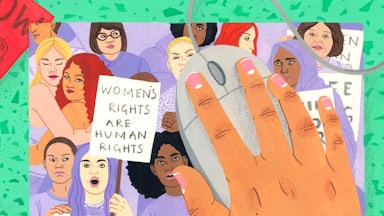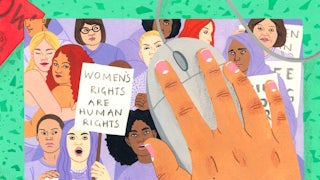When I graduated from college in 1991, Naomi Wolf was a feminist icon, and the only person of or close to my generation who merited the designation. The weighty feminist classics that had shaken the world from the midcentury through the 1970s—Simone de Beauvoir’s The Second Sex, Betty Friedan’s The Feminine Mystique, Germaine Greer’s The Female Eunuch, Susan Brownmiller’s Against Our Will—had been read by millions. But the 1980s were a more pessimistic, less ambitious time. Under Ronald Reagan, George Bush, and Phyllis Schlafly, feminism was in retreat. The women’s movement was still intellectually fruitful—scholars and activists debated sexuality, class, and race in anthologies published by university presses—but it had lost its visceral urgency. Feminist ideas no longer seemed to inspire people to picket their workplaces or leave their husbands. The days of the feminist bestseller were past, it appeared—and with them, the power of a transformative movement.
Published in 1990, Naomi Wolf’s breakout hit, The Beauty Myth, changed all that. Here was a feminist disquisition of old-school proportions: a big fat analysis of how profit and patriarchy conspire to make women feel bad about ourselves, joined with a call to action. Its author was pretty and presentable (“tourable,” as the publishing industry used to say before #MeToo). She could not be accused of sour grapes or resentment; a stereotypically “ugly” or even average-looking feminist would not have been able to attack the beauty industry with equal credibility. And like many books in the tradition of feminist screeds, The Beauty Myth’s power derives in part from prose that signifies both simplicity and profundity. Each chapter title, for example, is one word: “Work,” “Sex,” “Hunger.” A memorable image describes how the beauty myth functions: the iron maiden, a medieval torture instrument decorated on the outside with a smiling and attractive image of a young girl. The metaphor powerfully conveys how consumer society’s pretty pictures of pretty women mask the starvation and torture we endure in pursuit of beauty.
The argument was systemic, and its claims went beyond the obvious. Wolf did not merely point out that the consumer products, fashion, and advertising industries profit by aggravating women’s insecurities, she rightly argued that judging women by their looks—judging ourselves by our looks—props up and perpetuates patriarchy. By keeping us thin, the beauty myth encourages us to take up less space. If our worth depends on our attractiveness and pliability, we are rendered invisible as we age and gain knowledge and political, economic, and social power. And the pursuit of beauty intrudes on our minds and exhausts our valuable energies. At the same time, Wolf defended the pleasures of beauty. Deftly rejecting the austere, defensive posture in which feminism had become stuck, she helped put the desires of a new generation into words: Glamour, she wrote, “is merely a demonstration of the human capacity for being enchanted and is not in itself destructive. We need it, but redefined.”
The other day, after Wolf was kicked off Twitter for promulgating anti-vaccine claptrap, I took my copy of The Beauty Myth off the bookshelf to remind myself why she mattered to us back in the day. It’s the U.K. edition, and the cover shows a black and white photo of a naked woman with an entirely bandaged face sitting pensively under an end table that precisely frames her body. The copy, it turned out, wasn’t even mine—it belongs to my oldest friend, Emily, and, thrillingly, was inscribed by the author: “To Emily, Love and Hope, Naomi Wolf.”
The Beauty Myth was the kind of book we talked up, borrowed, and never gave back. It made feminists out of many of my contemporaries and helped inspire the feminist Third Wave, which included the Lesbian Avengers, abortion rights organizing, Take Back the Night marches, “pro-sex” feminism, and much more. It’s still taught in high schools; several years ago, I overheard a group of New York City schoolgirls discussing it on the subway with passion and righteous indignation. I was moved and proud that the 1990s feminism of my own youth was still alive and raising the consciousness of today’s young women.
Yet it’s easy to understand why my friend Emily has not, in recent decades, demanded the return of her signed copy. With each subsequent decade, Wolf has injected a little more madness into the cesspool of weird that we sometimes call “the discourse.” In 2012, she wrote a silly book all about her vagina and not much else: Vagina: A New Biography. (The less said about it the better.) Her most recent book, Outrages: Sex, Censorship, and the Criminalization of Love, about the relationship between the repression of homosexuality and societal attitudes toward divorce and prostitution, came out in 2019; a central argument was based on a historical error so embarrassing that the publisher was forced to unpublish it. (Wolf misunderstood the term “death recorded” to mean that a convict had been executed, when in fact it means the person was pardoned or their sentence commuted.) Still, to fangirl is pleasurable, and for that reason I preferred not to examine my youthful icons too carefully. Remaining loyal to the Naomi Wolf of the early 1990s, I chose to ignore her present-day existence for years. That is, until her recent turn to anti-vax insanity.
Wolf has tweeted that she overheard an Apple employee (who had attended a “top secret demo”) describing vaccine technology that can enable time travel. She has posited that vaccinated people’s urine and feces should be separated in our sewage system until their contaminating effect on our drinking water has been studied. She fears that while pro-vaccine propaganda has emphasized the danger the unvaccinated pose to the vaccinated, we have overlooked how toxic the vaccinated might be. And as the journalist Eoin Higgins reports, she is headlining an anti-vaccination “Juneteenth” event this month in upstate New York. (Yes, the organizers chose that date to suggest that vaccines are slavery.)
Wolf’s views on vaccines led Twitter to ban her from the platform for peddling misinformation. I don’t think anyone should be banned from Twitter for this reason: What counts as “fake news” can be a matter on which reasonable people may disagree, and I’m sure Twitter’s view of the world doesn’t much resemble mine, either. Still, at least three or four people I love hold ludicrous beliefs about the Covid-19 vaccines, the result entirely of internet conspiracy-mongering. I don’t take the matter lightly. When a public intellectual declines this far, we need to ask: Was she always full of shit?
Revisiting The Beauty Myth, I found it beautifully written, accessible, and righteous. I also found it daft.
One of the elements of the book I remember as most persuasive was all the statistics. It turns out, however, that they’re highly questionable. To take just one instance, Wolf gives the reader the impression that eating disorders are an existential threat to the female human. Twice within two pages, she says such disorders have increased “exponentially,” but a 2012 review of historical epidemiological data since 1930 found no such thing. A 2004 academic paper demonstrated that more than two-thirds of Wolf’s anorexia stats were wrong; the author coined the acronym WOLF to describe her approach: “Wolf’s Overdo and Lie Factor.” Citing the 2004 paper at The New York Times, Parul Sehgal singled out one harrowing example: Where Wolf placed deaths from eating disorders at 150,000 annually, the actual number at the time was closer to 50 or 60. For comparison, 150,000 was the number of coronavirus deaths in the United States that had occurred by the end of July 2020; 38,000 is the number of car accident deaths annually in the U.S. In a patriarchal society, women do tend to be overlooked, but a mass extinction event is hard to miss.
It’s not hard to say, of course, that even 50 deaths from anorexia are too many. Yet at the best, most respected moment of her career, Wolf was reporting on a genocide that never occurred—with a narrative that’s strikingly similar to QAnon’s hysteria over trafficked children imprisoned in caves. But Wolf’s faulty statistics are not the only problem with The Beauty Myth. In form, the book resembled the Second Wave classics, which called for massive societal transformation through collective action. Wolf did urge a Third Wave feminist movement, but her most dramatic exhortations are appeals to the individual, not to society. They’re almost anti-political: “If we are to free ourselves from the dead weight that has once again been made out of femaleness, it is not ballots or lobbyists or placards that women will need first; it is a new way to see.” And who or what do we need to see? Those familiar with the dominant culture of the 1980s won’t be surprised to learn the answer: ourselves. The Reagan-era perspective gets a special reveal in the book’s last line: “A generation ago Germaine Greer asked of women, ‘What will you do?’ What women did brought forth a quarter century of cataclysmic revolution.” The next phase, Wolf argued, depended on “what we decide to see when we look in the mirror.” Waxing positively neoliberal, she contends that “the real problem is our lack of choice.” Milton Friedman could not have said it better.
The individualism of Wolf’s early work hasn’t aged much better than the made-up facts. Nor is it unrelated to her recent devolution into fake vaccine science. A pandemic is a collective problem; vaccines a collective solution. Meanwhile, Wolf and her fellow vaccine resisters insist on their freedom to choose.
Rather than be shocked at how far afield from reality Wolf has wandered, it’s probably time to admit she’s always been wrong.








